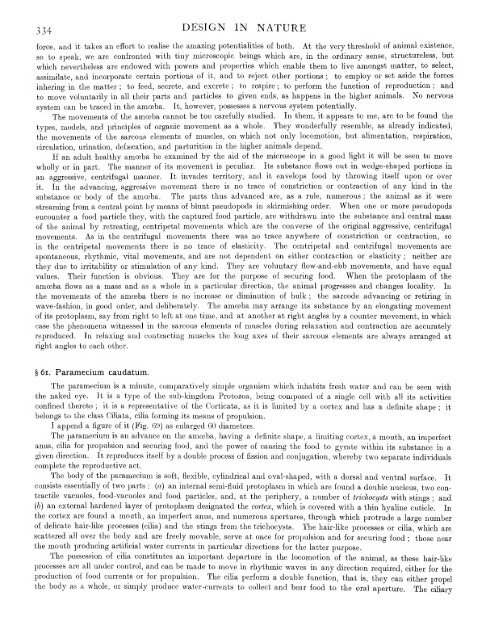You also want an ePaper? Increase the reach of your titles
YUMPU automatically turns print PDFs into web optimized ePapers that Google loves.
334 DESIGN IN NATURE<br />
force, and it takes an effort to realise the amazing potentialities of both. At the very threshold of animal existence,<br />
so to speak, we are confronted with tiny microscopic beings which are, in the ordinary sense, structureless, but<br />
which nevertheless are endowed with powers and properties which enable them to live amongst matter, to select,<br />
assimilate, and incorporate certain portions of it, and to reject other portions ; to employ or set aside the forces<br />
inhering in the matter ; to feed, secrete, and excrete ; to respire ; to perform the function of reproduction ; and<br />
to move voluntarily in all their parts and particles to given ends, as happens in the higher animals. No nervous<br />
system can be traced in the amoeba. It, however, possesses a nervous system potentially.<br />
The movements of the amoeba cannot be too carefully studied. In them, it appears to me, are to be found the<br />
types, models, and principles of organic movement as a whole. They wonderfully resemble, as already indicated,<br />
the movements of the sarcous elements of muscles, on which not only locomotion, but ahmentation, respiration,<br />
circulation, urination, defsecation, and parturition in the higher animals depend.<br />
If an adult healthy amoeba be examined by the aid of the microscope in a good light it will be seen to move<br />
wholly or in part. The manner of its movement is pecuHar. Its substance flows out in wedge-shaped portions in<br />
an aggressive, centrifugal manner. It invades territory, and it envelops food by throwing itself upon or over<br />
it. In the advancing, aggressive movement there is no trace of constriction or contraction of any Idnd in the<br />
substance or body of the amoeba. The parts thus advanced are, as a rule, numerous ; the animal as it were<br />
streaming from a central point by means of blunt pseudopods in skirmishing order. When one or more pseudopods<br />
encounter a food particle they, with the captured food particle, are withdrawn into the substance and central mass<br />
of the animal by retreating, centripetal movements which are the converse of the original aggressive, centrifugal<br />
movements. As in the centrifugal movements there was no trace anywhere of constriction or contraction, so<br />
in the centripetal movements there is no trace of elasticity. The centripetal and centrifugal movements are<br />
spontaneous, rhythmic, vital movements, and are not dependent on either contraction or elasticity ; neither are<br />
they due to irritability or stimulation of any kind. They are voluntary flow-and-ebb movements, and have equal<br />
values. Their function is obvious. They are for the purpose of securing food. When the protoplasm of the<br />
amceba flows as a mass and as a whole in a particular direction, the animal progresses and changes locality. In<br />
the movements of the amcBba there is no increase or diminution of bulk ; the sarcode advancing or retiring in<br />
wave-fashion, in good order, and deliberately. The amoeba may arrange its substance by an elongating movement<br />
of its protoplasm, say from right to left at one time, and at another at right angles by a counter movement, in which<br />
case the phenomena witnessed in the sarcous elements of muscles during relaxation and contraction are accurately<br />
reproduced. In relaxing and contracting muscles the long axes of their sarcous elements are always arranged at<br />
right angles to each other.<br />
§ 6i. Paramecium caudatum.<br />
The Paramecium is a minute, comparatively simple organism which inhabits fresh water and can be seen with<br />
the naked eye. It is a type of the sub-kingdom Protozoa, being composed of a single cell with all its activities<br />
confined thereto ; it is a representative of the Corticata, as it is limited by a cortex and has a definite shape ; it<br />
belongs to the class Ciliata, cilia forming its means of propulsion.<br />
I append a figure of it (Fig. 69) as enlarged 60 diameters.<br />
The Paramecium is an advance on the amoeba, having a definite shape, a hmiting cortex, a mouth, an imperfect<br />
anus, ciha for propulsion and securing food, and the power of causing the food to gyrate within its substance in a<br />
given direction. It reproduces itself by a double process of fission and conjugation, whereby two separate individuals<br />
complete the reproductive act.<br />
The body of the paramecium is soft, flexible, cylindrical and oval-shaped, with a dorsal and ventral surface. It<br />
consists essentially of two parts : (a) an internal semi-fluid protoplasm in which are found a double nucleus, two con-<br />
tractile vacuoles, food-vacuoles and food particles, and, at the periphery, a number of trichocysts with stings ; and<br />
(b) an external hardened layer of protoplasm designated the cortex, which is covered with a thin hyaline cuticle. In<br />
the cortex are found a mouth, an imperfect anus, and numerous apertures, through which protrude a large number<br />
of delicate hair-like processes (ciha) and the stings from the trichocysts. The hair-like processes or cilia, which are<br />
scattered all over the body and are freely movable, serve at once for propulsion and for securing food ; those near<br />
the mouth producing artificial water currents in particular directions for the latter purpose.<br />
The possession of ciha constitutes an important departure in the locomotion of the animal, as these hair-hke<br />
processes are all under control, and can be made to move in rhythmic waves in any direction required, either for the<br />
production of food currents or for propulsion. The ciha perform a double function, that is, they can either propel<br />
the body as a whole, or simply produce water-currents to collect and bear food to the oral aperture. The ciliary


